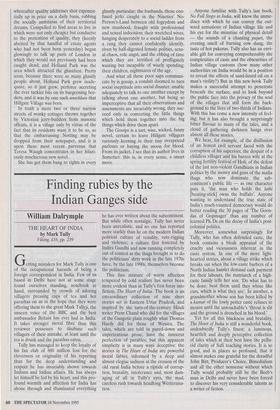Finding rubies by the Indian Ganges side
William Dalrymple
THE HEART OF INDIA by Mark Tully Viking, £16, pp. 239 Getting mistaken for Mark Tully is one of the occupational hazards of being a foreign correspondent in India. Few of us based in Delhi have not at some stage found ourselves standing, notebook in hand, surrounded by crowd's of adoring villagers pressing cups of tea and hot parathas on us in the hope that they were offering them to the great Mark Tullyji, the unseen voice of the BBC and the best ambassador Britain has ever had in India. It takes stronger moral fibre than this reviewer possesses to disabuse such villagers of their mistake, at least until the tea is drunk and the parathas eaten.
Tully has managed to keep the loyalty of his fan club of 880 million less for the cleverness or originality of his reporting than for the deep understanding and respect he has invariably shown towards Indians and Indian affairs. He has always let himself be led by his heart, and this pro- found warmth and affection for India has shone through and illuminated everything he has ever written about the subcontinent. But while often nostalgic, Tully has never been unrealistic, and no one has reported more starkly than he on the modern Indian political culture of venality, vote-rigging and violence; a culture first fostered by Indira Gandhi and now running completely out of control as the thugs brought in to do the politicians' dirty work in the late 1970s have, by the late 1990s, themselves become the politicians.
This fine mixture of warm affection tempered by cold realism has never been more evident than in Tully's first foray into fiction, The Heart of India. The book is an extraordinary collection of nine short stories set in Eastern Uttar Pradesh, and inspired by the turn-of-the-century Hindi writer Prem Chand who did for the villages of the Gangetic plain roughly what Thomas Hardy did for those of Wessex. The tales, which are told in pared-down and unpretentious prose, have the innocent perfection of parables; but this apparent simplicity is in many ways deceptive: the stories in The Heart of India are powerful moral fables, informed by a deep and almost elegiac sadness at the erosion of the old rural India before a riptide of corrup- tion, brutality, intolerance and, most dam- aging of all in Tully's eyes, the mad, careless rush towards headlong Westernisa- tion. Anyone familiar with Tully's last book, No Full Stops in India, will know the imme- diacy with which he can convey the out- ward sensations of Indian village life and his eye for the minutiae of physical detail — the sounds of a chanting pujari, the evening smell of burning cow dung, the taste of hot pakoras. Tully also has an envi- able gift for conveying comprehensibly the complexities of caste and the obscurities of Indian village customs (how many other authorities on India would be in a position to reveal the effects of sand-lizard oil on a man's virility?) But in this new book Tully makes a successful attempt to penetrate beneath the surface, and to look beyond the public face into the privacy of the soul of the villages that still form the back- ground to the lives of two-thirds of Indians. With this has come a new intensity of feel- ing; but it has also brought a surprisingly bitter flavour to many of the tales, and a cloud of gathering darkness hangs over almost all these stories.
We hear, for example, of the disillusion of an honest civil servant faced with the corruption of his superiors; the despair of a childless villager and his barren wife at the spring fertility festival of Holi; of the defeat of the last non-violent Gandhians in Indian politics by the money and guns of the mafia thugs who now dominate the sub- continent's public life — as one character puts it, 'the man who holds the lathi [beating-stick] owns the buffalo'. Anyone wanting to understand the true state of India's much-vaunted democracy would do better reading the 30 pages of 'The Goon- das of Gopinager' than any number of learned Ph. Ds on the decay of India's post- colonial politics.
Moreover, somewhat surprisingly for Tully, who has often defended caste, the book contains a bleak appraisal of the cruelty and viciousness inherent in the caste system. In one of the more light- hearted stories, about a village strike which breaks out when the low-caste barbers of a North Indian hamlet demand cash payment for their labours, the matriarch of a high- caste family tells her son: 'Do what has to be done: beat them until they whine like curs, which is what they are'. In another, a grandmother whose son has been killed by a kumar of the lowly potter caste refuses to mourn until the untouchable's 'throat is slit and the ground is drenched in his blood.'
Yet for all this blackness and brutality, The Heart of India is still a wonderful book, undoubtedly Tully's finest: a luminous, heartfelt and deeply perceptive collection of tales which at their best have the pellu- cid clarity of Sufi teaching stories. It is so good, and in places so profound, that it almost makes one grateful for the dreadful John Birt, Producer's Choice, Bimedialism and all the other nonsense without which Tully would probably still be the Beeb's man in Delhi and never have been forced to discover his very considerable talents as a writer of fiction.


















































































 Previous page
Previous page